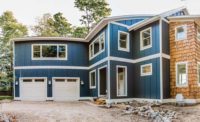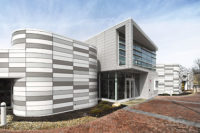“Building with ICFs and the opportunity to make a home that can serve as a future model for building green, affordable, sustainable housing is the most interesting aspect of the job for me,” says Valmore “Chip” Gauthier. The residential builder, who is the owner of V.A. Gauthier Construction, specializes in new construction and remodeling for residential applications. The company, based out of Grass Valley, Calif., serves as a master distributor and factory-trained installer for BuildBlock ICFs and certified geothermal installer of ground source heat pumps by Hydro-Temp Corp. The builder has been in business for 25 years and is one of the West Coast’s most aggressive advocates for green building, particularly for ICF projects.
Because V.A. Gauthier Construction’s passion lies in a niche market—namely ICFs and geothermal systems—work has been slim for the company.
“In this economic climate I’ve been able to keep busy with smaller projects,” he says.
In addition to the contracting company, Gauthier is looking into starting a consulting business to advise other builders and homeowners of the best practices and opportunities in green building. The focus will be on energy efficient design, sustainable techniques to make homes last, and in general, creating aesthetically pleasing living spaces that also maximize function.
“To reach a broader audience, I am looking at using video as a tool to illustrate the processes and details that help people approach various aspects of planning, home building and improvement,” Gauthier says, adding that he utilizes the company Organic Media to create videos, documenting the projects he works on.
Operation Habitat
Recently, V.A. Gauthier worked on a Habitat for Humanity Blitz Build Week. The challenge was to build a single family home in seven days. Gauthier was responsible to solicit volunteers, construction suppliers and manufacturers, a draft person, structural engineer and subcontractors, and oversee the construction of the home. The house template was already part of a pre-design owned by NC Habitat for Humanity.
“They wanted to have this house built stick frame but I was not interested in the project unless we could do it with ICFs and a geothermal ground source heat pump,” says Gauthier.
Nevada County Habitat for Humanity Executive Director Debbie Arakel was the company’s direct contact for the project. At the time, she was building her own ICF house and was open to the idea given that the unit could be built for the same cost or less as the proposed stick frame version.
Gauthier did some research to find out if he could get enough donations of materials and labor to attempt the project. After approximately a month of planning, the company was fairly confident that the project could be completed within budget. Arakely was reluctant but believed in Gauthier’s confidence. Ultimately, she and the board of directors allowed V.A. Gauthier to move forward.
|
JOBSITE Architect: Tony Rosas Associates Inc. Nevada City, Calif. Builder/Owner: Nevada County Habitat for Humanity General Contractor: VA Gauthier Construction |
“In a Blitz Build, you can have the foundation in before the start date but nothing else,” says Gauthier, adding that all labor must be from volunteers. “The real challenge was to convert the stick frame partial drawings to ICFs without changing any outside features or reducing the interior size footprint. I was able to do this, plus add a 42-square-foot mechanical room to accommodate the GSHP, bore hole, hot water heater, solar PV inverter, fire sprinkler control center, and a Venmar Heat Recovery Ventilator. The 1,508-square-foot house footprint on the 3,410-square-foot lot left very little margin for error.”
When the Nevada County Habitat for Humanity was obtaining from the City of Grass Valley permission for its Heritage Oaks Subdivision, design criteria for the aesthetic features of the homes and landscaping were imposed. The homes are designed to fit in with the historical and traditional architecture of downtown Grass Valley. The architectural design features include Victorian gables, Miners cabin-style covered porches, and board and bat features, complementing the local milieu. The project homes were designed by Tony Rosas & Associates.
At the time of the subdivision design, ICFs were not included in the concept so some of the hurdles to overcome included meeting the pre-designed criteria of the outside elevations and the overall pre-determined design could not have much alteration.
The final look had to meet the approval of both Habitat for Humanity and the Grass Valley Building and Planning Departments. The architect wanted to ensure the gable end ornamentation remained intact in the final design.
A Difficult But Rewarding Task
“I wasn’t able to enlist enough volunteers skilled in ICF construction to build the house in a week,” laments Gauthier. “Then it rained the first two days, delaying installation of the ICFs to the concrete slab. Once the week was finished, I stayed on for six more months until the house was completed.”
Such devotion and passion can typically be found on Habitat sites: giving back to the community for a greater good isn’t just rewarding, it’s the community that bonds all involved that make this Jimmy Carter-founded foundation worthwhile. As passionate as the volunteers are that help, the manufacturers also deserve a tip of the hat.
The ICF system was provided by BuildBlock. The wall bracings were Reachcraft. Floor joists were made by Truss-Joist. James-Hardie cement board siding was used for exterior siding. For the insulation, BASF closed-cell spray foam applied was installed.
“There are many good reasons for a homeowner to consider building a new house with ICF techniques,” says Gauthier. “First and foremost, ICF homes are anything but non-descript concrete bunkers. Virtually any type of interior or exterior wall treatments, gables or other adornments that one would employ with a conventional wood frame house can be done with ICFs.
“There are a myriad of additional benefits when using ICFs, including: they are extremely fire, earthquake and storm resistant; they shut out exterior noise; with the proper design, ICFs are extremely energy efficient (compare R-50 or R-60 walls with R-10 or R-20 wood frame walls); with very little maintenance, ICF homes will last a very long time (and no termites). I’ve built many wood frame houses spanning an entire career and I have taken that technology as far as I can, so I highly recommend anyone considering building a home to look into ICF construction.”









